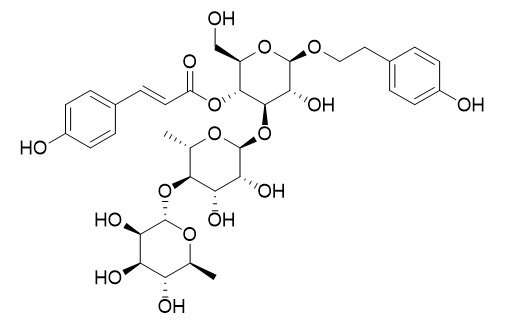Ligupurpuroside B
Ligupurpuroside B has antioxidant activity.
Inquire / Order:
manager@chemfaces.com
Technical Inquiries:
service@chemfaces.com
Tel:
+86-27-84237783
Fax:
+86-27-84254680
Address:
1 Building, No. 83, CheCheng Rd., Wuhan Economic and Technological Development Zone, Wuhan, Hubei 430056, PRC
Providing storage is as stated on the product vial and the vial is kept tightly sealed, the product can be stored for up to
24 months(2-8C).
Wherever possible, you should prepare and use solutions on the same day. However, if you need to make up stock solutions in advance, we recommend that you store the solution as aliquots in tightly sealed vials at -20C. Generally, these will be useable for up to two weeks. Before use, and prior to opening the vial we recommend that you allow your product to equilibrate to room temperature for at least 1 hour.
Need more advice on solubility, usage and handling? Please email to: service@chemfaces.com
The packaging of the product may have turned upside down during transportation, resulting in the natural compounds adhering to the neck or cap of the vial. take the vial out of its packaging and gently shake to let the compounds fall to the bottom of the vial. for liquid products, centrifuge at 200-500 RPM to gather the liquid at the bottom of the vial. try to avoid loss or contamination during handling.
Food Funct.2022, 13(23):12105-12120.
Nat Prod Sci.2018, 24(2):109-114
Oxid Med Cell Longev.2021, 2021:6647107.
Processes2021, 9(11),2065.
Appl. Sci.2023, 13(2), 860.
J Anal Toxicol.2021, bkab015.
Korean J. Medicinal Crop Sci.2021, 29(6):425-433
J Ethnopharmacol.2017, 206:73-77
Nutrients.2019, 11(11):E2694
Molecules.2019, 24(11):E2044
Related and Featured Products
J Agric Food Chem. 2001 Jun;49(6):3113-9.
Antioxidative activities of phenylethanoid glycosides from Ligustrum purpurascens.[Pubmed:
11410017]
Tea and kudingcha (bitter tea) are the two most popular beverages consumed in China. Tea derived from the leaves of Camellia sinensis has been well studied for its various health benefits, but there are very limited data on the biological activities of bitter tea derived from the leaves of Ligustrum purpurascens (LP).
METHODS AND RESULTS:
The present study was carried out to characterize the antioxidants present in the bitter tea brewed from the leaves of LP. It was found that the crude glycoside fraction possessed strong protection against oxidation of human low-density lipoprotein (LDL). The column chromatographic separation led to the isolatation of five phenylethanoid glycosides, namely, acteoside, ligupurpuroside A, cis-Ligupurpuroside B, trans-Ligupurpuroside B, and osmanthuside B. When acteoside was heated in the boiling water, it was isomerized to form isoacteoside. Acteoside, isoacteoside, and ligupurpuroside A purified from LP were protective, whereas cis-Ligupurpuroside B, trans-Ligupurpuroside B, and osmanthuside B exhibited no protection to human LDL from Cu(2+)-medicated oxidation. Acteoside, isoacteoside, and ligupurpuroside A were also effective in preventing the peroxyl free radical-induced oxidation of alpha-tocopherol in human LDL. The antioxidant activities of acteoside, isoacteoside, and ligupurpuroside A were comparable to that observed for a green tea antioxidant, (-)-epicatechin gallate. The inhibitory effect of these three phenylethanoid glycosides on oxidation of human LDL and alpha-tocopherol was dose-dependent at concentrations of 5-40 microM.
CONCLUSIONS:
The present results suggest that the bitter tea beverage derived from LP contains effective antioxidants that may have an equal benefit as a green tea beverage.
J Nat Prod. 2003 Jun;66(6):851-4.
Antioxidative glycosides from the leaves of Ligustrum robustum.[Pubmed:
12828473 ]
METHODS AND RESULTS:
Phytochemical investigation of the ethanol extract of the leaves of Ligustrum robustum, monitored by a bioassay involving the hemolysis of red blood cells induced by 2,2'-azo-bis(2-amidinopropane) dihydrochloride, led to the isolation of three new glycosides, ligurobustosides M (1), N (2), and O (3), along with 10 known ones, osmanthuside B (4), osmanthuside B6 (5), acteoside (6), ligupurpuroside A (7), Ligupurpuroside B (8), ligurobustoside C (9), ligurobustoside E (10), ligurobustoside I (11), cosmosiin (12), and rhoifolin (13). The structures of the new compounds were elucidated by spectroscopic methods.
CONCLUSIONS:
Seven of the glycosides showed stronger antioxidant effects than the standard, trolox.



